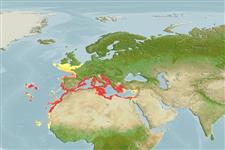>
Anguilliformes (Eels and morays) >
Muraenidae (Moray eels) > Muraeninae
Etymology: Muraena: Latin, muraena = morey eel (Ref. 45335).
Eponymy: According to Eschmeyer’s description of the scorpionfish “…the name is from Greek mythology, Helena sister of Castor” -a reference to Helen of Troy. [...] (Ref. 128868), visit book page.
More on author: Linnaeus.
Issue
Type species of genus.
Muraena augusti (Kaup, 1856) is considered as a valid species by Jiménez et al. (2007: Ref. 58348). Page to be created soon.
Environment: milieu / climate zone / distribuzione batimetrica / distribution range
Ecologia
marino associati a barriera corallina; distribuzione batimetrica 1 - 801 m (Ref. 58348), usually 100 - 300 m (Ref. 58348). Subtropical; 52°N - 13°N, 32°W - 36°E
Eastern Atlantic: from the the British Isles to Senegal and the Mediterranean.
Length at first maturity / Size / Peso / Age
Maturità: Lm 75.5, range 69 - ? cm
Max length : 150 cm TL maschio/sesso non determinato; (Ref. 12382); common length : 80.0 cm TL maschio/sesso non determinato; (Ref. 3397); peso massimo pubblicato: 6.5 kg (Ref. 58348); Età massima riportata: 38 anni (Ref. 58348)
Short description
Chiavi di identificazione | Morfologia | Morfometria
A nocturnal and territorial species (Ref. 12382), commonly lurking in holes, and writhing snakelike through crevices, under rocks or corals (Ref. 58348). Feeds on fish, crabs and squid (Ref. 12382). It seldom attacks unless provoked (Ref. 3256). A gonochoristic species (Ref. 32169). Utilized fresh and eaten broiled, boiled and baked; the skin can be used for leather (Ref. 9987).
Migrate to offshore waters to spawn (Ref. 98745).
Smith, D.G. and E.B. Böhlke, 1990. Muraenidae. p. 136-148. In J.C. Quero, J.C. Hureau, C. Karrer, A. Post and L. Saldanha (eds.) Check-list of the fishes of the eastern tropical Atlantic (CLOFETA). JNICT, Lisbon; SEI, Paris; and UNESCO, Paris. Vol. 1. (Ref. 4450)
IUCN Red List Status (Ref. 130435: Version 2025-1)
Threat to humans
Traumatogenic (Ref. 4690)
Human uses
Pesca: scarso interesse commerciale; Acquario: Acquari pubblici
Strumenti
Special reports
Download XML
Fonti Internet
Estimates based on models
Preferred temperature (Fonte Biblio.
123201): 13.1 - 16.2, mean 14.4 °C (based on 181 cells).
Phylogenetic diversity index (Fonte Biblio.
82804): PD
50 = 0.5010 [Uniqueness, from 0.5 = low to 2.0 = high].
Bayesian length-weight: a=0.00056 (0.00048 - 0.00066), b=3.27 (3.23 - 3.31), in cm total length, based on LWR estimates for this species (Ref.
93245).
Trophic level (Fonte Biblio.
69278): 4.2 ±0.61 se; based on food items.
Resilienza (Fonte Biblio.
120179): Molto basso, tempo minimo di raddoppiamento della popolazione più di 14 anni (tmax=38.1; tm=7.1; K=0.078).
Fishing Vulnerability (Ref.
59153): Very high vulnerability (79 of 100).
🛈
Climate Vulnerability (Ref.
125649): Moderate to high vulnerability (53 of 100).
🛈
Nutrients (Ref.
124155): Calcium = 11.6 [5.8, 23.4] mg/100g; Iron = 0.433 [0.231, 0.841] mg/100g; Protein = 19.3 [17.0, 21.8] %; Omega3 = 0.193 [0.077, 0.603] g/100g; Selenium = 40.8 [19.0, 84.1] μg/100g; VitaminA = 42.5 [12.0, 154.1] μg/100g; Zinc = 0.452 [0.295, 0.682] mg/100g (wet weight);
